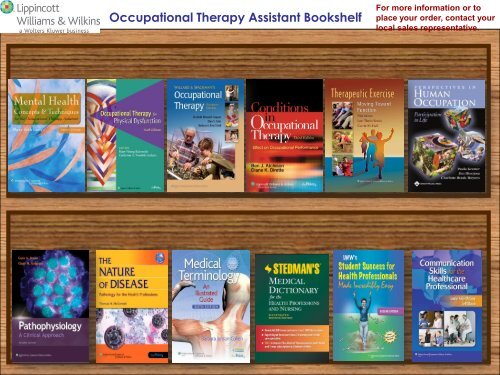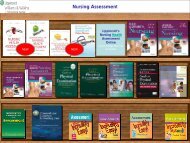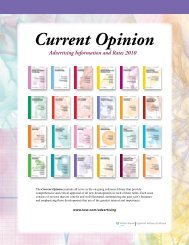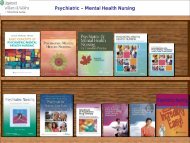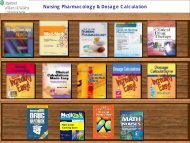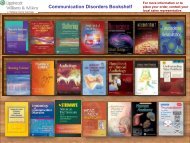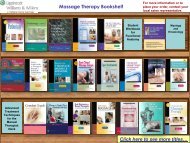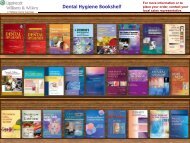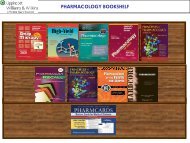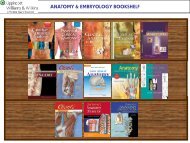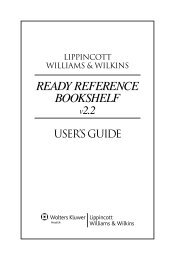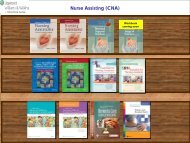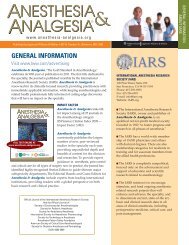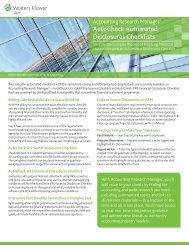Occupational Therapy Assistant Bookshelf - Lippincott Williams ...
Occupational Therapy Assistant Bookshelf - Lippincott Williams ...
Occupational Therapy Assistant Bookshelf - Lippincott Williams ...
You also want an ePaper? Increase the reach of your titles
YUMPU automatically turns print PDFs into web optimized ePapers that Google loves.
<strong>Occupational</strong> <strong>Therapy</strong> <strong>Assistant</strong> <strong>Bookshelf</strong><br />
For more information or to<br />
place your order, contact your<br />
local sales representative.
Mental Health Concepts and<br />
Techniques for the <strong>Occupational</strong><br />
<strong>Therapy</strong> <strong>Assistant</strong>, Fourth Edition<br />
Mary Beth Early MS, OTR<br />
February 2008/ 624 pp./ 61 illus./ 978-0-7817-7839-8<br />
Features:<br />
•Case Examples (in some chapters and in Appendix A)<br />
provide real-world scenarios to bridge theory to practice.<br />
•Concepts Summary and Vocabulary Review Boxes<br />
reinforce the chapter content.<br />
•Tables and boxes, which highlight key information, show<br />
examples of group protocols and documentation, and list<br />
common acronyms.<br />
•NEW TO THE FOURTH EDITION:<br />
•New Chapter 4 dedicated to the <strong>Occupational</strong> <strong>Therapy</strong><br />
Practice Framework.<br />
•New topics in Section V including Education, Work, Social<br />
Participation, and Coping Strategies.<br />
•Point-of-View quotes offer a quote from a patient,<br />
therapists or family member and items to reflect upon<br />
based on the quote.<br />
•Chapter Review Questions test comprehension of the key<br />
concepts<br />
•Chapter objectives outline what reader should understand<br />
by end of chapter
<strong>Occupational</strong> <strong>Therapy</strong> for Physical<br />
Dysfunction, Sixth Edition<br />
Mary Vining Radomski MA, OTR, FAOTA<br />
Catherine A. Trombly Latham ScD, OTR, FAOTA<br />
2007/ 1432 pp./ 764 illus./978-0-7817-6312-7<br />
Instructor Resources:<br />
•Images from book<br />
•Tables from book<br />
•PowerPoint Slides<br />
•Test Generator<br />
•Solutions to Clinical<br />
Reasoning boxes<br />
Features:<br />
•Uses the <strong>Occupational</strong> Functioning Model (OFM) to<br />
organize evaluation and treatment for an integrated<br />
approach<br />
•Case Examples model problem formation, treatment<br />
planning, and the therapist reasoning process<br />
•Clinical Reasoning in OT Practice Boxes include critical<br />
thinking questions that link chapter content to case<br />
examples<br />
•Procedures for Practice Boxes provide step-by-step<br />
directions for applying concepts to practice<br />
•"International Classification of Functioning, Disability and<br />
Health" (ICIDH-2) language and concepts<br />
•Learning Objectives and Diagrams illustrate each<br />
chapter's learning goals and relevance to the<br />
<strong>Occupational</strong> Functioning Model<br />
•Research Note Boxes apply research to practice<br />
•Summary Review Questions summarize each chapter and<br />
test the reader's understanding
Willard & Spackman’s <strong>Occupational</strong><br />
<strong>Therapy</strong>, Eleventh Edition<br />
Elizabeth Blesedell Crepeau PhD, OTR/L, FAOTA<br />
Ellen S. Cohn ScD, OTR, FAOTA<br />
Barbara A. Boyt Schell PhD, OTR, FAOTA<br />
2008/ 1191 pp./ 354 illus./ 978-0-7817-6004-1<br />
Instructor Resources:<br />
•PowerPoint Presentations<br />
•Learning Activities<br />
•Image and Table Collection<br />
•Case Studies from Text<br />
•Sample Syllabi<br />
•Faculty Guide<br />
Student Resources:<br />
•Quizzes<br />
•Full Text Online<br />
•Supplemental Readings<br />
•Web Resources<br />
Features:<br />
•Updated content reflects trends in the field toward the<br />
centrality of occupation to practice, and the link between<br />
theory and practice<br />
•New reorganized chapters and units<br />
•New personal narrative chapters introduce students to<br />
people with disabilities<br />
•Inclusion of the terminology of the International<br />
Classification of Function<br />
•Practice Dilemmas poses a practice question or problem<br />
for students to reason through and respond to<br />
•Ethical Dilemmas focus on ethical issues<br />
•Case Studies<br />
•Commentary on the Evidence sections provide succinct<br />
commentary on the current evidence to support practice<br />
•Powerful Quotations<br />
•Provocative Questions
Conditions in <strong>Occupational</strong> <strong>Therapy</strong>:<br />
Effect on <strong>Occupational</strong> Performance,<br />
Third Edition<br />
Ben J. Atchison PhD, OTR, FAOTA<br />
Diane K. Dirette PhD, OT<br />
2006/ 512 pp./ 70 illus./978-0-7817-5487-3<br />
New Edition<br />
Publishing<br />
Fall 2011!<br />
Features:<br />
•Updated language to match the new standard language<br />
set by the AOTA The Language of the <strong>Occupational</strong><br />
<strong>Therapy</strong> Practice Framework is woven into the presentation<br />
of each condition.<br />
•Case studies at the end of every chapter help students<br />
apply the content to clinical situations for real life<br />
application.<br />
•Contributions from leading experts in the field<br />
•New chapters on Anxiety Disorders and Cardiopulmonary<br />
Disorders<br />
•Expanded art program, which includes more photos,<br />
drawings, charts, graphs, etc.<br />
•Numerous pedagogical features including chapter<br />
outlines, special boxes, tables and displays, study questions,<br />
and suggested readings
Therapeutic Exercise: Moving Toward<br />
Function, Third Edition<br />
Carrie M. Hall PT, MHS<br />
Lori Thein Brody PT, MS, SCS, ATC<br />
Instructor Resources:<br />
•Image Bank<br />
•PowerPoint Slides<br />
•Test Generator<br />
•Answers to Building Blocks<br />
•Video Clips<br />
Student Resources:<br />
•Video Clips<br />
•Additional chapter material<br />
not found in the text<br />
•Image Bank<br />
October 2010/ 960 pp./ 875 illus./ 978-0-7817-9957-7<br />
Features:<br />
•NEW! Building Blocks aim to construct knowledge from the<br />
material presented in the chapter and are located<br />
throughout each chapter. Answers are provided on<br />
thePoint<br />
•NEW! Case Studies will be included in each chapter to<br />
further expand on the subject matter.<br />
•NEW! Over 200 new photos and figures will be included in<br />
this edition<br />
•Organized by region, this text provides information to:<br />
- Decide which exercise to teach<br />
- Show how to teach the exercise<br />
- Evaluate the prescribed program for the desired<br />
functional outcome<br />
•Terminology follows that used in the "APTA's Guide to<br />
Physical <strong>Therapy</strong> Practice"<br />
•Intervention boxes show samples of exercise prescriptions<br />
•Self-Management boxes provide step-by-step exercises<br />
written directly for the client<br />
•Patient-related instruction boxes address patient<br />
education issues
Perspectives in Human Occupation:<br />
Participation in Life<br />
Paula Kramer PhD, OTR, FAOTA<br />
Jim Hinojosa PhD, OT, FAOTA<br />
Charlotte Brasic Royeen PhD, OTR, FAOTA<br />
2003/ 352 pp./ 105 illus./978-0-7817-3161-4<br />
Features:<br />
•Provides a firm foundation on the emerging perspectives<br />
of occupation<br />
•Fosters an understanding of where the profession is today<br />
as well as where the various scholars are headed with their<br />
unique perspectives<br />
•Includes issues to be considered when implementing these<br />
perspectives into practice<br />
•Designed to support the educational standards set by the<br />
Accreditation Council for <strong>Occupational</strong> <strong>Therapy</strong> Education<br />
(ACOTE)
Pathophysiology: A Clinical Approach<br />
Second Edition<br />
Carie A. Braun; Cindy M. Anderson<br />
Textbook: January 2011/ 608pps/ 370 illus/ 978-1-60547-304-8<br />
Study Guide: February 2011/ 176pps/ 21 illus/ 978-1-60831-187-3<br />
Instructor Resources:<br />
•Test generator<br />
•Image bank<br />
•PowerPoint slides<br />
•Answers to exercises in the text<br />
•Additional case studies<br />
Pathophysiology animations<br />
•Additional learning activities with<br />
answers<br />
•Lesson plans<br />
Student Resources:<br />
•Pathophysiology animations<br />
•Quiz bank<br />
•Interactive case studies<br />
•For-sale companion study guide<br />
Features:<br />
• NEW! Fully revised chapters are now broken into modules, breaking<br />
complex information into smaller pieces and providing a building-block<br />
approach to the material.<br />
• NEW! Each chapter closes with Clinical Models, which apply the<br />
conceptual understanding of altered human function to specific<br />
conditions, and demonstrating the practical clinical application of the<br />
knowledge gained throughout the chapter.<br />
• Conceptual approach and organization facilitate application and<br />
retention of key information.<br />
Sophisticated full-color art program engages students and includes<br />
detailed illustrations of the human body in health and disease.<br />
• An application exercise in the last chapter requires students to apply the<br />
complex pathophysiologic concepts that they have learned to diabetes<br />
mellitus, emphasizing the practical nature of the material through<br />
application.<br />
• From The Lab: provides additional content on relevant laboratory and<br />
diagnostic information, including unique aspects of the lab test and lab<br />
results for students to consider.<br />
• Research: highlights new findings and demonstrates how research can be<br />
incorporated into clinical practice.<br />
Recommended Review: briefly reviews related concepts covered earlier in<br />
the text or from prior anatomy and physiology coursework.
The Nature of Disease: Pathology for the<br />
Health Professions<br />
Thomas H. McConnell MD, FCAP<br />
Instructor Resources:<br />
•LiveAdvise<br />
•Test generator<br />
•PowerPoint slides<br />
•Lecture notes<br />
•Answers to in-text exercises<br />
•Image bank<br />
•Lesson Plan Guide<br />
Student Resources:<br />
•247-question interactive quiz bank<br />
•Animations<br />
- Acute Inflammation<br />
- Wound Healing<br />
- Neuromuscular Transmission<br />
2006/ 739 pp./ 551 illus./978-0-7817-8203-6<br />
Features:<br />
•Back to Basics provide an overview of normal anatomy and<br />
physiology<br />
•Major Determinants of Disease lists offer overview of key<br />
determinants of development of disease<br />
•Case studies center on the details of a real patient's illness<br />
•The Road Not Taken scenarios imagine how the course of<br />
disease might have been different, with a better outcome, if<br />
certain factors were altered<br />
•Test questions reinforce principles and hone skills<br />
•Opening quotes introduce each chapter with entertainment<br />
•Chapter overviews<br />
•Chapter outlines<br />
•Learning objectives and answers<br />
•Key terms and concepts<br />
•Feature boxes:<br />
- Key Points<br />
- The Clinical Side<br />
- Lab Tools<br />
- Basics in Brief<br />
- History of Medicine
Medical Terminology: An Illustrated<br />
Guide, Fifth Edition<br />
Barbara Johnson Cohen, BA, MSEd<br />
2007/ 806 pp./ 318 illus./ 978-0-7817-7667-7/ Text & Online Course:<br />
978-0-7817-6579-4<br />
Instructor Resources:<br />
•Sample chapters from each book<br />
•Sample instructor ancillaries<br />
•Test Generator<br />
•PowerPoint slides<br />
•Lesson Plans<br />
•Word Search Activities (with answers)<br />
•Crossword Activities (with answers)<br />
•Fill-in-the-blank tables<br />
•On-line appendices<br />
Student Resources:<br />
•Flashcards<br />
•Audio Pronunciation<br />
•Glossary<br />
•Image Labeling Exercises<br />
•Spelling Bee<br />
•Question Bank<br />
Features:<br />
•Introduction to medical dictionaries<br />
•Appendix on how to use Stedman's Medical Dictionary<br />
•Special interest boxes:<br />
- Focus on Word: a closer examination of words, origins, word<br />
parts, etc., and prefixes, suffixes, and pronunciation<br />
- Clinical Perspectives: clinical information and real-world<br />
application of medical terminology<br />
- Health Professions: information about different fields and realworld<br />
context for medical terminology<br />
- For Your Reference: additional terms and information in tabular<br />
format<br />
•Pretests for each chapter test existing knowledge and review<br />
material from previous chapters<br />
•Case studies and case study questions show context and real-life<br />
clinical situations<br />
•Chapter review exercises and answers<br />
•Appendices on commonly used symbols, abbreviations and<br />
meanings, and metric measurements and US equivalents<br />
•LiveAdvise is a free resource with every book<br />
•Customizable Online Course available as an additional purchase<br />
•Includes content and exercises complementary to information in the<br />
book<br />
•Each chapter section starts off with an overview
Stedman’s Medical Dictionary for the<br />
Health Professions and Nursing,<br />
Seventh Edition<br />
Stedman’s<br />
2011/ 2512 pp./ 1000 illus./ 978-1-60831-692-2<br />
Ancillary Assets:<br />
• More than 40,000<br />
pronunciations online<br />
• 5,600 illustrations<br />
available online<br />
Features:<br />
• Over 56,000 terms<br />
• Nearly 65 valuable appendices<br />
• 1,000 illustrations<br />
• Anatomical insert by Anatomical Chart Company<br />
• Written pronunciations for every term<br />
• British alternative spellings<br />
• Precision-cut thumb tabs<br />
• A to Z organization for easier look up<br />
• Over 70 leading consultants from the fastest growing<br />
nursing and health professions contributed to the<br />
enhancements of this latest edition<br />
• FREE One year subscription to Stedman’s Online<br />
• FREE version of Stedman’s PLUS Medical/Pharmaceutical<br />
Spellchecker ($99 value)
LWW’s Student Success for Health<br />
Professions Made Incredibly Easy,<br />
Second Edtiion<br />
<strong>Lippincott</strong> <strong>Williams</strong> & Wilkins<br />
February 2011/ 326 pp./ 173 illustrations/ 978-1-60913-784-7<br />
Instructor Resources:<br />
•Test Bank<br />
•Syllabi for 8-week, 10-week, and<br />
16-week courses<br />
•PowerPoint presentations<br />
•Strategies for effective teaching<br />
•Chapter-specific teaching tips<br />
•WebCT/BB/Angel course<br />
cartridges<br />
Student Resources:<br />
•Learning styles assessment<br />
•Self-Paced Online Course<br />
•“Playing for Real” narratives<br />
•Printable planner pages<br />
•Sample cover letters and<br />
resumes<br />
•Career resource links<br />
Features:<br />
• Revised and updated with a more user-friendly organization<br />
and design, but retains the health professions focus, the<br />
concise and approachable narrative, and the fun features<br />
and art.<br />
• The first and only student success text designed specifically<br />
for health professions students and programs!<br />
•Self-Paced Online Course with activities and a final exam<br />
• Winning Strategy Lists set forth the objectives for the chapter<br />
• Playing for Real Scenarios: show students how content is<br />
applied to real-life situations in the classroom and in clinical<br />
practice<br />
• Tips from the Pros offer expert advice and proven strategies<br />
for overcoming study and test-taking problems<br />
• The Finish Line Summaries highlight the key concepts and<br />
skills that students need to master<br />
• Keeping Score Questions and Activities challenge students<br />
to consider how they will apply the content
Communication Skills for the Health<br />
Professional<br />
Laurie Kelly McCorry, PhD<br />
Jeff Mason<br />
February 2011/ 256 pp./ 50 illus./ 978-1-58255-814-1<br />
Features:<br />
• Presents the fundamentals of communication skills geared<br />
specifically for students in the allied health professions<br />
• Includes a clear, concise presentation of the principles of<br />
communication theory as well as verbal and nonverbal<br />
communication<br />
• Instructs the health care professional on communicating with<br />
patients whose ability may be impacted by anxiety, cultural<br />
differences, language differences and other situations.<br />
• Organized into three main sections outlining basic communication<br />
principles and their uses in clinical and administrative settings<br />
• Chapters on cultural sensitivity, adapting communication to adjust<br />
to a patient’s ability to understand, and dealing with other roadblocks<br />
provide students with techniques to handle many situations that they<br />
will encounter as a healthcare professional.<br />
• Role Play boxes interspersed throughout the chapters teach students<br />
how to work through various scenarios that they may encounter in<br />
practice.<br />
• Clinical applications, included in each chapter, offer more complex<br />
scenarios to aid the students in developing the critical thinking skills<br />
they will need to apply in practice.


